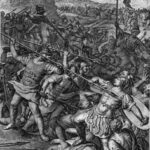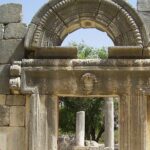וַיְדַבֵּר אֱלֹהִים אֶל־מֹשֶׁה וַיֹּאמֶר אֵלָיו אֲנִי יְהוָה׃ וָאֵרָא אֶל־אַבְרָהָם אֶל־יִצְחָק וְאֶל־יַעֲקֹב בְּאֵל שַׁדָּי וּשְׁמִי יְהוָה לֹא נוֹדַעְתִּי לָהֶם׃
Translated literally, God’s opening statement to Moshe here reads as follows. ‘I am HASHEM. And I appeared to Avraham, to Yitzhaq, and to Ya’aqov as El Shaddai and my name HASHEM I was not known to them.’ This statement is difficult to parse on a grammatical level and also presents a major interpretative problem because numerous verses in Bereishit makes clear that the avot did know the name HASHEM.
The grammatical difficulty is usually solved by positing that the ablative ב before El Shaddai also applies to the name HASHEM so the verse reads ‘and by my name HASHEM I was not known to them’. Rashbam, however, punctuates the verse differently, reading it with a pause in the middle and an extra implied ו: ‘And I appeared to Avraham, to Yitzhaq, and to Ya’aqov as El Shaddai, but my [true] name is HASHEM. And [thus] I was not known to them’. Both Ralbag and Rabeinu Bahya explain the grammatical difficulty in the verse by arguing that it should be construed as ‘and my name HASHEM is/was not known to them’, but that it is written ‘and my name HASHEM I was not known to them’ because God’s total unity necessarily entails that He and His name are indivisible.
Many solutions have been suggested for the second problem.
- Rav Sa’adya Gaon adds the implied word ‘alone’. God was known to the avot as both El Shaddai and HASHEM, but not as HASHEM alone.
- Rashi interprets the name El Shaddai as denoting the making of promises and HASHEM as denoting the fulfilling of them. The avot received God’s promises, but it is only now that the children of Israel will see them fulfilled.
- Ibn Ezra and Sforno argue that El Shaddai represents a lower, more indirect level, of divine providence than HASHEM. The avot received protection and blessing, but did not witness miracles that transcended the order of nature.
- Ramban and Rabeinu Bahya agree with Ibn Ezra, but add that the verse also refers specifically to Moshe’s higher state of prophecy, an interpretation also recorded by Rambam in Moreh Nevuhim. God was ‘seen’ by the avot in visions, but ‘known’ by Moshe at a more profound level. Only through this highest level of prophecy was he able to perform open miracles.
According to most of these interpretations, the verse is not talking about awareness of any given name. Instead, the verse means that the avot were familiar with HASHEM as a proper noun or signifier, but in its full significance as a description of God’s essence. Ralbag interprets ‘not known to them’ as referring to the Children of Israel, rather than the avot, and explains the verse as a declaration that even though the children of Israel did not yet have a true understanding of His nature, God was still activating his covenant.
Ibn Ezra quotes a Qaraite author who argued that, in fact, the avot did not know the name HASHEM, and that when the term is used in Bereishit it is from the perspective of Moshe. He also quotes a Rabbi Merinos, who argued that ‘and my name HASHEM’ is a figure of speech connoting an oath, so that the verse means ‘and, indeed, on My name, I have not yet been known to them’.
For more on parshat Va’eira, see Haggadah Berurah, the Haggadah that helps you tell the story of yetziat mitzrayim.



Leave a Reply